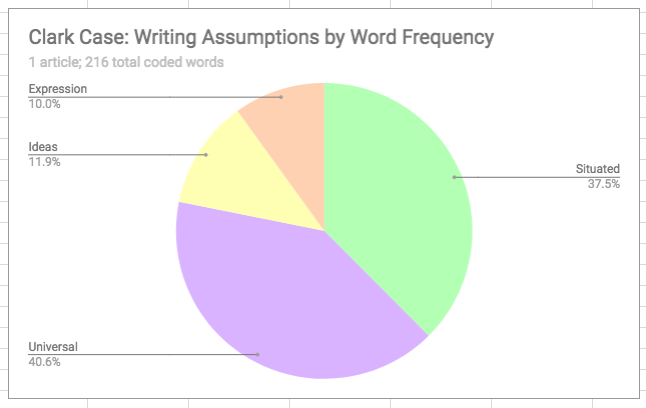The Clark Case
On Getting Credit or Getting Results, or Who Owns a Trend?
Clark Intro
When professional drag queen Kimberly Clark started her semi-satirical YouTube channel in 2014, she included typical beauty videos, such as item-by-item reviews from her latest shopping trip—the ubiquitous haul. Clark, who also appears in video as Chris Gianco, ran a small channel in terms of views and subscribers until November 2015 when she uploaded her first “anti-haul,” a compilation of items she was “not going to buy" criticizing everything from cost to color organization to font choice.
Putting together two much beloved features of the internet—shopping and snarking—made for a winning recipe, and other YouTubers took note. Anti-hauls became a trend; over 800,000 such videos appeared within two years of Clark’s original upload (Forbes, 2017). Clark addressed the proliferation of videos mirroring her original idea in her 14th anti-haul (2016). Clark’s channel also earned high views; her November 2015 haul video, for example, had 17,000 views compared to the 130,000 for the anti-haul.
Her introductory comments brought together several views of authorship and ownership. She thanked other beauty YouTubers who had done an anti-haul by name and credited those who had influenced her thinking. She also positioned her work as a unique expression of a long-standing idea, ultimately concluding that public circulation of her idea mattered most. Clark’s anti-hauls earned some beauty media attention (Eby, 2017; Forbes, 2017) but no articles appeared in my search. Her comments are the only text in this case.
Hey y’all it’s me, Kimberly Clark and welcome to this, my 14th anti-haul video, aka, what I’m not going to buy! [sung: What I’m not going to buy.] I should learn, I should learn Jackie Aina’s song she made. Hey girl! Hey, Jackie. Thank you for doing an anti-haul video. Thank you for making a song.—Kimberly Clark, 2016
I mean, I’ve seen plenty of anti-haul videos where people are like, “I’m just doing this because y’all requested it, and I don’t know what it is, and it’s trendy, so I’m just gonna do it.” I’ll take that too; I love that. Still spreading the anti-consumerism.—Kimberly Clark, 2016
Coding Results
Clark's case illustrated how viewing writing as situated can provide communal benefits. Arguments about plagiarism invoke this assumption by claiming, for example, lack of citation is not wrong but rather in accord with the audience’s expectation for this genre. Thus Mary Lamb (1996) argued feminist rhetors legitimately drop citations because the discourse community they address expect and understand the unmarked quotations as allusions; the recognition of community matters more than that of source. Similarly, Porush (1998) and Adler-Kassner et al. (2008) both point to the differing citation norms underpinning public information writing, where knowledge circulation rather than authorial credit matters.
Clark (2016) evoked four major theories of authorship in her short speech, two sets in almost perfect balance with each other. Arguments approaching writing as situated made up 38% of the total claims; this included an assumption that the original author determines what counts as plagiarism ("don't worry about crediting me; I don't care"). Another 40% represents the countervailing view that some writing principles are universally required. Clark may have disavowed a personal need for credit but she was generous when discussing others; she named fellow YouTube beauty posters, for example, enacting the YouTube form of "courtesy" citation as defined by Mick Doherty (1998).

The debate between Zax and Bialosky’s camp first turn on questions of intent and, by extension, character. This class of arguments was most common, at 24.7% of total words. Bialosky defended herself by arguing that any copying was "inadvertent," implying that plagiarism requires a willful action and denying she committed such an act. Bialosky's statement instead emphasized her effort, describing a "multiyear writing process" to both explain how such mistakes could happen and to demonstrate a commitment to her writing project. Similarly, Bialosky's statement stressed that the memoir arose from Bialosky's own experience, something by definition difficult to plagiarize. Yet, Zak also turned to biographical details to question Bialosky's defense and her overall character. Zak provided plagiarism policies from three universities Bialosky attended, arguing as a student and teacher Bialosky should have been well aware that her work, by any academic definition, included plagiarized passages. But this is not the only contentious point. This case invoked all six theories, with the oppositional pair of expression and ideas in almost perfect balance.
The other two assumptions, writing meaning ideas (12%) and writing meaning expression (10%), show similar balance. Clark oscillated between claiming her own original ideas (“If you want to hear more in-depth thoughts of mine”) and acknowledging them as expressions of a longstanding theme (“I just created a specific form. This trend has been there"). Her argument did not touch on writing as character or work assumptions, perhaps given her prioritization of circulation over credit. Credit-giving, after all, is a way of recognizing an author’s labor and makes possible a judgment of a known character. The circulation model, on the other hand, measures only the value of the ideas carried within the work being copied.
Circulating Theories of Writing
Writing is Situated sees discourse communities as setting citation norms; insiders and plagiarizers judge best; professional standing refutes plagiarism.
Writing Requires Work assumes all writing requires intellectual labor (Roach, 2017) and so all writing deserves source-crediting; the writing process is difficult.
Writing Means Ideas takes up the solitary genius definition of writing, where novel ideas and original arguments matter and boilerplate language or facts do not.
Some of Writing is Universal argues some writing principles, e.g., giving credit, apply to all situations; college teaching and plagiarism policies serve as general benchmarks.
Writing Reflects Character views the act of writing as inherently ethical; intention matters, and writing decisions reflect one's overall character.
Writing Means Expression all work is intertextual, so the form and language used to convey ideas is what matters; reworking ideas is fair use.